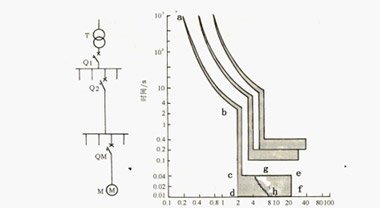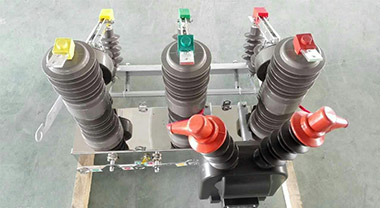The arc extinguishing principle of vacuum circuit breaker
Vacuum circuit breakers use vacuum as the arc extinguishing medium. The pressure in the arc extinguishing chamber under high vacuum is very low (only 1.3×10-4~1.3×10-5 Pa), only a few gas molecules exist, the insulation strength between the electrodes is high, and there is fast insulation Intensity recovery speed (up to 20kV/μs), small contact gap, small arc energy, and easy arc extinguishment in vacuum. : When the circuit breaker breaks the current, the moment the contacts are just separated, the current will shrink to a certain point or a few points where the contacts have just separated, and the resistance between the contacts will increase sharply and the temperature will increase rapidly until a contact occurs. The evaporation of the metal simultaneously forms a very high electric field strength, resulting in strong field strength emission and gap breakdown, and then a vacuum arc is formed. The high temperature of the arc melts the material of the contact part, and the vaporized metal vapor maintains the arc. When the current crosses zero, because there are very few gas molecules in the surrounding vacuum, and because the contact generates a magnetic field when the current passes, the arc rapidly spreads along the tangent direction of the contact surface under the force of the magnetic field, so the arc metal vapor and the carried The mass points quickly diffuse to the surrounding metal shield, and are cooled and re-condensed, so that the contact gap returns to a relatively high vacuum state within a few microseconds after the current crosses zero. Dielectric strength, so that the arc can be extinguished without reigniting when the current crosses zero for the first time.
Vacuum interrupters can be divided into vacuum interrupters for circuit breakers, vacuum interrupters for load switches, vacuum interrupters for contactors, and vacuum interrupters for special purposes according to their specific requirements, such as use, location, and breaking capacity. Room and other types.
The vacuum interrupter has a variety of structural types, but no matter which structural type is adopted, it is composed of airtight insulation system, conductive system, shielding system, bellows, etc., as well as conductive rods, fixed components, guide sleeves and other parts and components composition.
(1) The structure of the airtight insulation system. It is composed of a gas-tight insulating cylinder made of glass, ceramics or glass-ceramics, a movable end cover plate, a fixed end cover plate and a stainless steel bellows.
(2) The role of airtight insulation system. It is a metal part that supports the moving and static contacts and the shielding cover, and it is airtightly welded with these parts to ensure a high vacuum in the arc extinguishing chamber.
(3) Requirements for airtight insulation system:
- In order to ensure good airtightness between glass, ceramics or glass-ceramics and metal, in addition to strict operation techniques when sealing, the air permeability of the material itself is also required to be as small as possible, and the internal gas release is limited to The minimum value ensures that the vacuum degree of the vacuum interrupter shall not be lower than a specified value within 10-20 years.
- It is necessary to ensure that the insulation strength has a sufficient safety factor.
- A certain degree of mechanical strength must be ensured, especially the movable and fixed cover plate must have certain elasticity, so that it can withstand the mechanical vibration during transportation, installation and operation, and avoid damage to the vacuum interrupter.
- The airtightness, insulation and mechanical strength of the entire airtight insulation system during the service life must be guaranteed.




